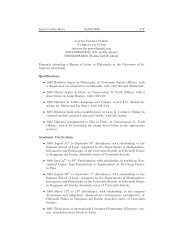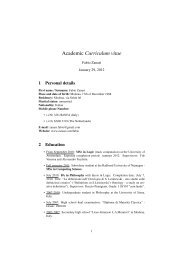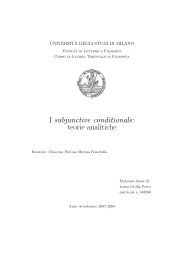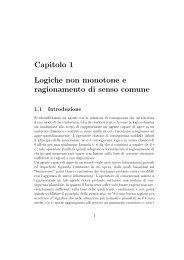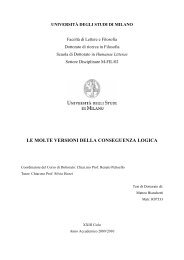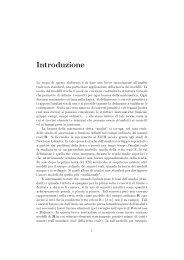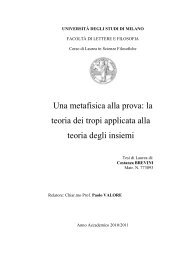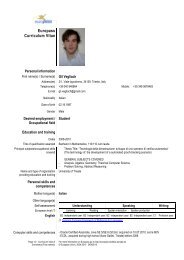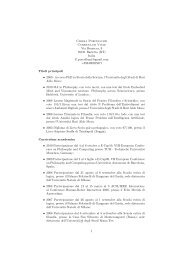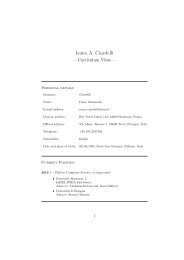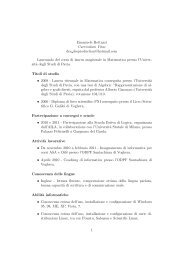Ω-Theory: Mathematics with Infinite and Infinitesimal Numbers - SELP
Ω-Theory: Mathematics with Infinite and Infinitesimal Numbers - SELP
Ω-Theory: Mathematics with Infinite and Infinitesimal Numbers - SELP
You also want an ePaper? Increase the reach of your titles
YUMPU automatically turns print PDFs into web optimized ePapers that Google loves.
CHAPTER 1. Ω-CALCULUS<br />
6. For all r ∈ R, Fr = {λ ∈ Pfin(Ω) : r ∈ λ} ∈ Q;<br />
7. ∅ ∈ Q <strong>and</strong> Pfin(Ω) ∈ Q.<br />
Proof. The first part of this Proposition follows from Proposition 1.4.4.<br />
To prove part 2, we will show that, if A = Qϕ,ψ <strong>and</strong> B = Qη,γ, then A∩B = Qδ,φ,<br />
<strong>and</strong> δ <strong>and</strong> φ have the same Ω-limit. If A ⊆ B or B ⊆ A, the thesis follows from<br />
part 1. Let’s suppose that this is not the case. Let’s call ξ = limλ↑Ω ϕ(λ) <strong>and</strong><br />
ζ = limλ↑Ω η(λ). If ξ = ζ, Axiom 1 ensures that there is a function ν such as<br />
limλ↑Ω ν(λ) = ξ −ζ. If we define η ′ = η +ν <strong>and</strong> γ ′ = γ +ν, we have that Qη ′ ,γ ′ = Qη,γ<br />
<strong>and</strong><br />
lim η<br />
λ↑Ω ′ = lim γ<br />
λ↑Ω ′ = ζ + ξ − ζ = ξ<br />
We have shown that, <strong>with</strong>out loss of generality, we can suppose<br />
Now, it’s clear that<br />
<strong>and</strong><br />
lim ϕ(λ) = lim ψ(λ) = lim η(λ) = lim γ(λ)<br />
λ↑Ω λ↑Ω λ↑Ω λ↑Ω<br />
Qϕ−η,ψ−γ = Qϕ,ψ ∩ Qη,γ<br />
lim(ϕ(λ)<br />
− η(λ)) = lim(ψ(λ)<br />
− γ(λ)) = 0<br />
λ↑Ω λ↑Ω<br />
<strong>and</strong> that’s what we wanted to prove.<br />
The proof of part 3 is by converse. Let’s suppose A ∈ Q <strong>and</strong> B ∈ Q. From<br />
the definition we have that, for all functions ϕ <strong>and</strong> ψ, the hypothesis Qϕ,ψ = A or<br />
Qϕ,ψ = B implies limλ↑Ω ϕ(λ) = limλ↑Ω ψ(λ). Since the implication holds if both the<br />
premises are true, we have that, if for ϕ <strong>and</strong> ψ the equality Qϕ,ψ = A ∪ B holds,<br />
then limλ↑Ω ϕ(λ) = limλ↑Ω ψ(λ), <strong>and</strong> so we conclude A ∪ B ∈ Q, as we wanted.<br />
To prove the first implication of part 4, let’s suppose A ∈ Q, so that there exist<br />
ϕ, ψ such as A = Qϕ,ψ <strong>and</strong> limλ↑Ω ϕ = limλ↑Ω ψ. Let’s define the functions:<br />
<strong>and</strong><br />
η(λ) =<br />
γ(λ) =<br />
ϕ(λ) if λ ∈ A<br />
1 if λ ∈ A c<br />
ϕ + 1 if λ ∈ A<br />
1 if λ ∈ A c<br />
Clearly, Qη,γ = A c <strong>and</strong>, by part 3 of Proposition 1.4.4, limλ↑Ω η(λ) = limλ↑Ω ϕ(λ),<br />
while limλ↑Ω γ(λ) = limλ↑Ω ϕ(λ)+1. This shows that A c ∈ Q. Conversely, if A c ∈ Q,<br />
we can apply the same argument to show that A = (A c ) c ∈ Q.<br />
To prove part 5, we can consider the function c0 <strong>and</strong> the function<br />
<br />
c<br />
0 if λ ∈ F<br />
ϕ(λ) =<br />
1 if λ ∈ F<br />
By definition, we have Qc0,ϕ = F c , so ϕ is eventually constant (take λ0 = n<br />
i=1 λi)<br />
<strong>and</strong>, by Axiom 2, limλ↑Ω ϕ(λ) = 0. This implies F c ∈ Q <strong>and</strong>, by part 4, F ∈ Q.<br />
12




